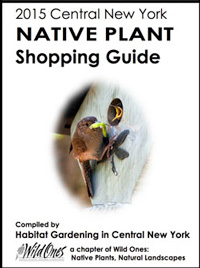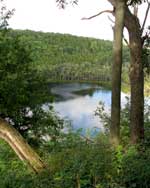|
| | Skaneateles Conservation Area |
Thank yous to Dr. Bob McGee and Geoff Griffiths for their expertise on last Saturday's field trip. It's a very interesting project! If you missed our tour of the Skaneateles Conservation Area last week, there's another chance to tour this area, including the forest at Guppy Farm, this Saturday June 20. See the story below for more information on attending. A few milkweeds still available
We have just a few unclaimed 6-packs of butterfly weed and swamp milkweed left ($7 for a 6-pack). Email me if you'd like some.
Show Me Help Me ToursWe have some Show Me Help Me Tours scheduled, so check upcoming newsletters for dates. Our Habitat Garden and Our Edible Garden toursI'm hosting a number of tours on the following dates. Feel free to attend more than one if you're interested since different things are blooming each week. Tuesday June 23 at 6:30 pm Saturday June 27 at 9:30 am Wednesday July 1 at 6:30 pm Sunday July 5 at 4:00 pm Friday July 10 at 6:30 pm DirectionsNative Plant Shopping Guide See details below to get your free Guide to finding native plants in Central New York. We welcome feedback on your experiences with the vendors and the plants. Janet Allen, President
|
 |
 |
 We know that we need to plant native pollinator-friendly plants and eliminate pesticides that harm or even kill pollinators. But you can also celebrate National Pollinator Week by purchasing a sign from Xerces Society that helps spread the word about the importance of gardening for pollinators. From the "outside," a pollinator-friendly yard may not look very different from a yard that doesn't help pollinators. Making our efforts visible by displaying a sign could multiply the benefits of your garden by encouraging neighbors to take similar action. Purchase at the Xerces store at http://www.xerces.org/store/. I've displayed this sign for a number of years, and it still looks like new. And some good news!
After being one of only five states without an official State Pollinator Week, New York finally issued a declaration making this week not only a national pollinator week, but also a state pollinator week. Thank you to all of you who emailed, wrote, or called Gov. Cuomo.
|
 |
 |
What is this weird object and why is an ant exploring it? The weird object is the seedpod of twinleaf ( Jeffersonia diphylla), named to honor Thomas Jefferson in 1792 by the "Father of American Botany," Benjamin Smith Barton. Before it opened, the seedpod looked like a happy frog. Another interesting feature of this plant is its (duh) twin leaves, which look like a butterfly. This plant is not only interesting in many ways, but it makes a wonderful groundcover in shade, once established. So what about the ant?Yet another interesting thing about this plant is how it's dispersed: with the help of ants. So what's in it for the ants? The seeds have a tasty, lipid-rich structure called an elaiosome. Ants and some other creatures (such as yellow jackets!) love these and in the process cart away the seeds, dispersing them away from the parent plant. Of course, for an ant, a few feet away is about as far as they take them.
Twinleaf is not the only plant ants help disperse. Ants also help disperse bloodroot (Sanguinaria canadensis), trillium (Trillium), and quite a few other spring woodland plants.
|
 |
 |
|
Merlin Bird ID is getting even better
|
|
| | A purple finch (still wet from bathing) identified by Merlin |
From the Merlin website: Merlin is designed to be a birding coach for beginning and intermediate bird watchers.
Merlin asks you the same questions that an expert birder would ask to help solve a mystery bird sighting.
Notice that date and location are Merlin's first and most important questions. It takes years of experience in the field to know what species are expected at a given location and date. Merlin shares this this knowledge with you based on more than 70 million sightings submitted to eBird from birders across the United States and Canada.Merlin Photo ID
I've had a lot of success with the free Merlin app just by submitting basic info about the time, location, and so on, but now they're testing an even more useful version: Merlin Photo ID. You simply submit a photo of the bird you want to identify. It's still in beta testing, and by trying it out, you'll help make the app even better. Try it out at http://merlin.allaboutbirds.org/photo-id/
|
 |
 |
|
| | Our never-occupied bat house |
Finally, there's some good news for bats, a much-maligned, but very beneficial creature. Ten years ago, a fungus was introduced in the US that decimated populations of bats in American and Canada. Now for the first time, scientists have treated bats with White Nose Syndrome and have released them. Read more about this program from The Nature Conservancy and learn how bananas are involved! And bats are pollinators, too. Learn more about pollination and bats from Bat Conservation International.
|
 |
 |
Skaneateles Conservation Area
Show Me Help Me Field Trip
Sat. June 20
This area is an abandoned USDA Soil Research Station (and briefly an Army helicopter training site). Much of it now consists of highly-degraded fields of buckthorn, honeysuckle, privet, and multiflora rose. Volunteers have been removing some of the invasives within the last few years, but they could use some ideas about good replacements. See http://skaak.org/the-areas/federal-farm/ for historic aerial images of the site, and for some history. Randy will "SHOW" us what they've been doing to remove the invasives and what the result has been over the last few years, and he's interested in our "HELP" as part of this Show Me Help Me Field Trip. Because this is public land, only licensed applicators are allowed to apply herbicides, so many of the invasives re-sprout and need to be recut over and over. It has made room for some natives to pop up on their own, but those need to be protected from herbivores, and it's only a limited number of species. Geoff Griffiths, a Ph.D. Ecology student at SUNY-ESF, will help answer the more difficult questions and provide suggestions of his own. His Wildflower Restoration project is being done on a site (the Guppy Farm, on the other side of Gully Road) that was reforested earlier and has less of an invasive species problem, but native woodland wildflowers are absent. See more about that project at http://skaak.org/flora-2/wildflower-restoration/.
RSVPs
Sat. June 20 at 10 am. Open to all. RSVP to Randy Nonenmacher at ranonenmacher@twcny.rr.com. Details will be sent to registrants. |
 |
 |
|
2015 Native Plant Shopping Guide
|
 The most common question people have asked over the years is "Where can we get native plants?" Central New York does seem to be behind other areas of the country in making native plants available, but each year there are more plants available, and our Native Plant Shopping Guide will tell you where to find them. Download it for free on our websiteThe Guide is in three parts:
Or you can download the complete Guide (Introduction, List by scientific name, and List by common name).
Please read the introduction! In addition to information about the vendors, it suggests guidelines for choosing plants. For example, it's beneficial to choose species rather than cultivars. The Introduction provides additional information. New this year is a link (the asterisk in the left hand column) to a map of each plant's distribution county by county as part of the Biota of North America Program at http://bonap.net/NAPA/Genus/Traditional/County. If you're looking for a particular plant, be sure to call ahead to be sure the vendor has them in stock on any particular day. Thank you to our vendors for taking the time and effort to provide a list of their native plant offerings. Special thanks to Randy Nonenmacher, Carol Biesemeyer, and Randi Starmer for their assistance. And THANKS to all of you who choose native plants! |
 |
|
|
 This tradition has been a highlight at Clark Reservation for years! Join Dr. Leopold as he introduces us to the many trees and plants found here at Clark Reservation. You may even spot a rare plant or two along the way. After the hike, join the Council of Park Friends for refreshments. WHEN: Sun. June 21 at 2 pm WHERE: Clark Reservation State Park FREE with admission to the park ($4/car). For more info...
|
|
Baltimore Woods Happenings
|
Here are just a few of the many events at Baltimore Woods. Note that there is a FEE for some programs. Visit their website to REGISTER online.Butterfly Chase
Sat. June 20 11:00 am - noon
All ages
Frog Catching Party
Sat. June 27 10:30 - noon
Family event for ages 3 and up
Frogs and FirefliesSat. June 27 8:30-9:30 * PM* Ages 7 and up Summer Nature Day CampsJuly 6 - August 28 A variety of camps for all ages. Check the website for details.
|
|
MOST Exhibit:
Losing a Legacy
|
|
| |
Climbing a glacier in Glacier Nat'l Park in 1977 - disappearing in my lifetime
|
The Museum of Science & Technology (MOST) has a photography exhibit, "Losing a Legacy: A Photographic Story of Disappearing Glaciers," chronicling the disappearance of glaciers from Glacier National Park in Montana due to climate change. WHEN: Ends June 30 WHERE: MOST, 500 South Franklin St. Syracuse (315) 425-9068 Directions and parkingFor more info about the exhibit...
|
Since HGCNY is a chapter of the national organization Wild Ones, when you become a member of Wild Ones, you're automatically a member of HGCNY, too. And since Wild Ones is an official not-for-profit, your membership is tax-deductible.
It's easy to become a member, receive the bimonthly Wild Ones Journal, and support our mission.
|
As more of us participate on our Facebook page at www.facebook.com/hgcny, this will become a useful resource for asking (and answering!) local HGCNYers' questions about habitat gardening.
|
 Visit Our Habitat Garden website for information on providing habitat, earth-friendly gardening practices, plants, and various creatures here in Central New York. |
Visit Our Edible Garden website to see an example of a local vegetable and fruit garden. An edible garden is a perfect complement to your habitat garden. Email me if you want to receive a vegetable gardening e-newsletter.
|
|
 |
|